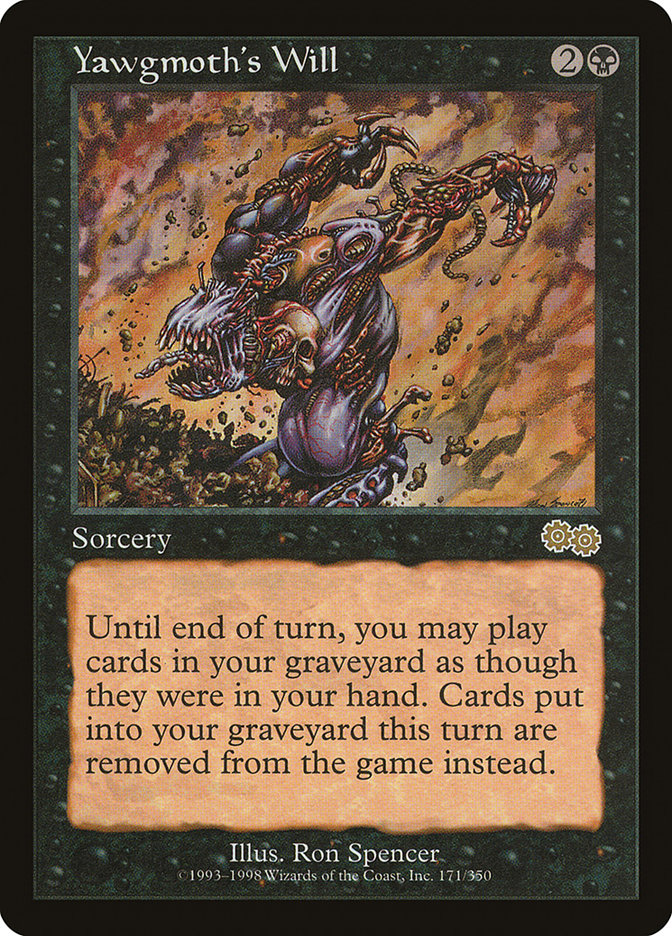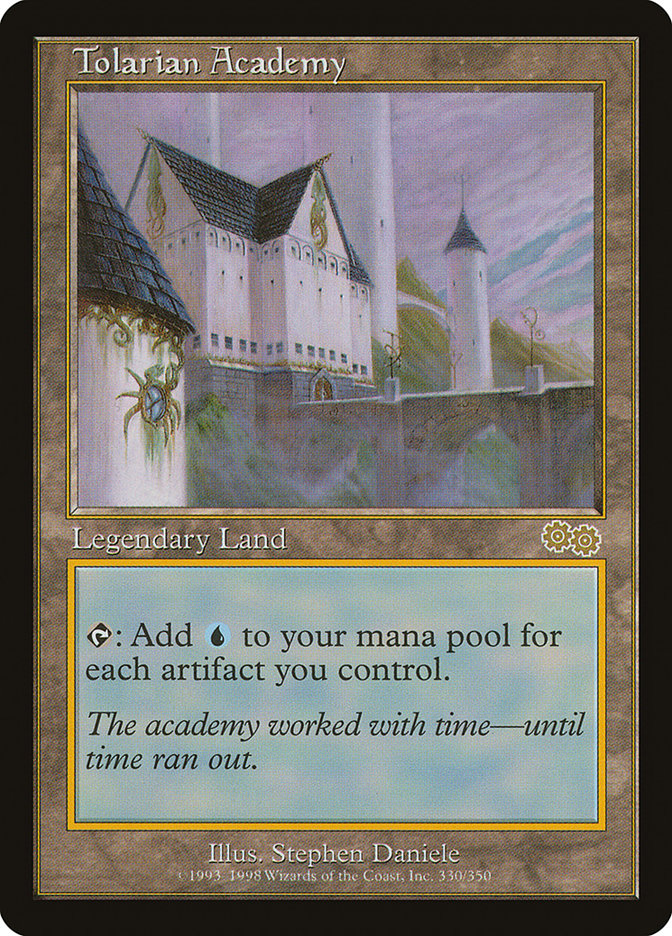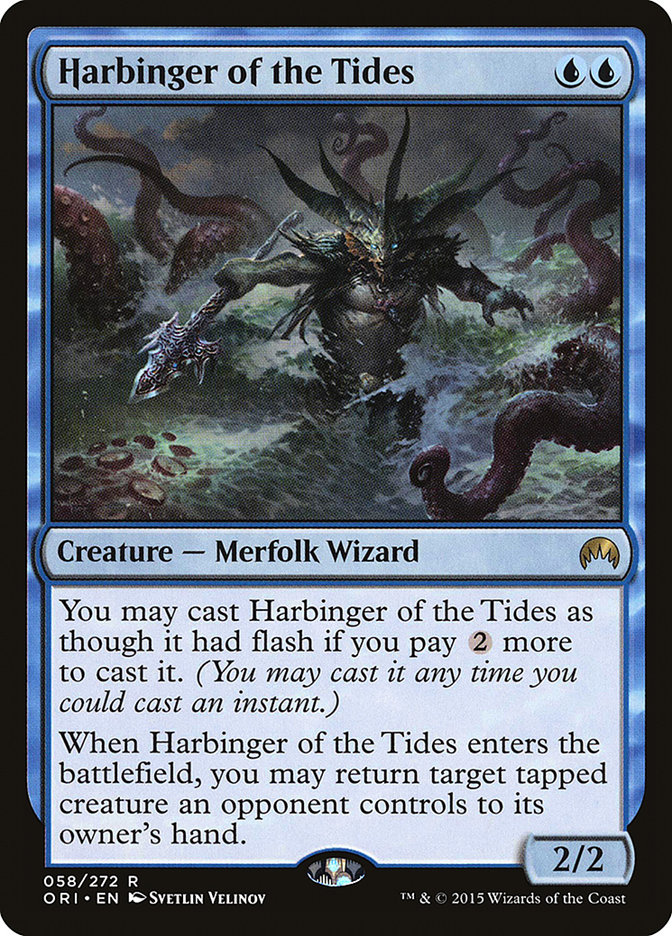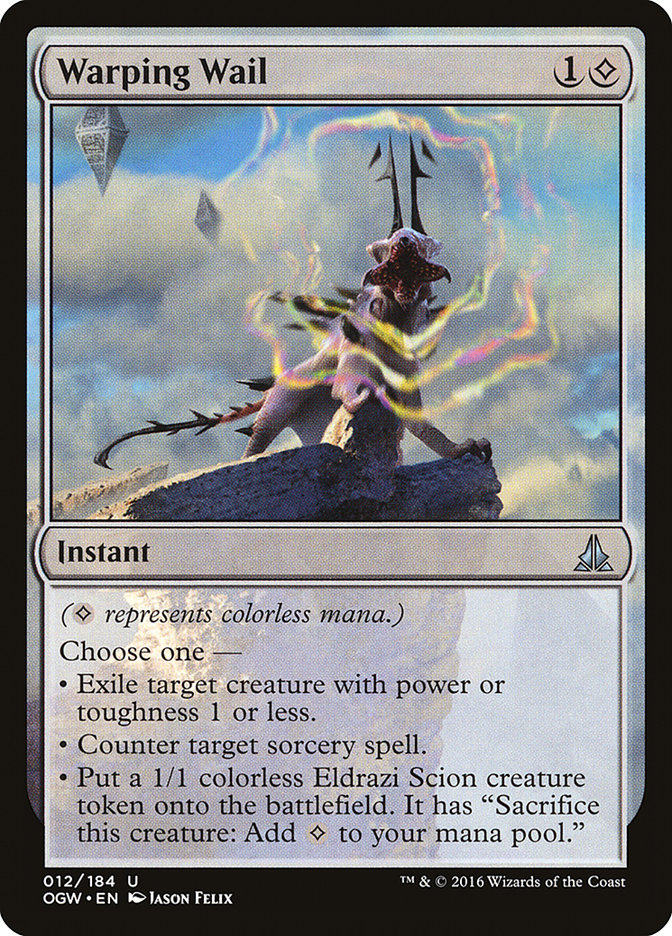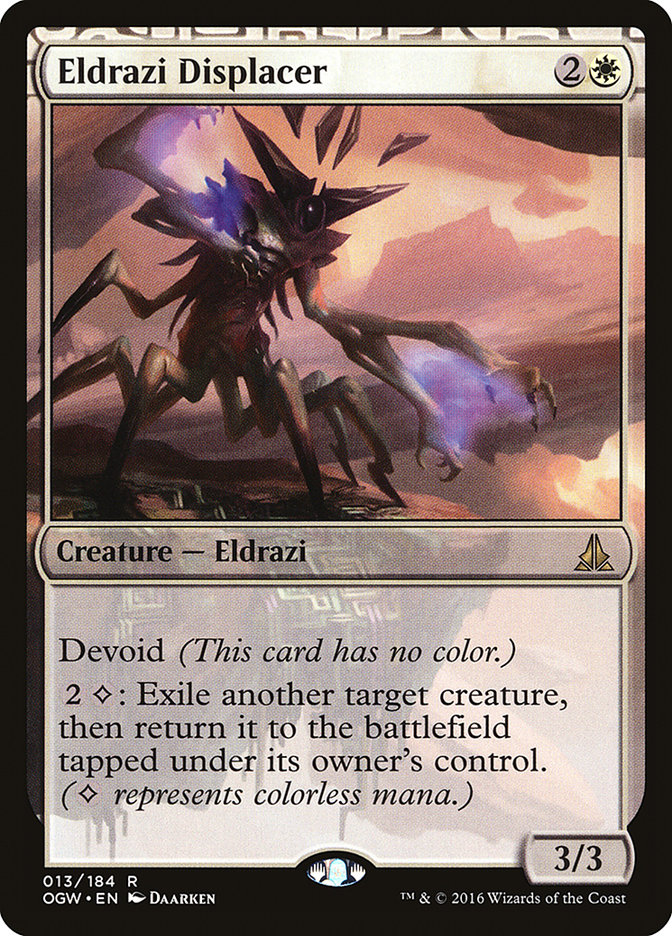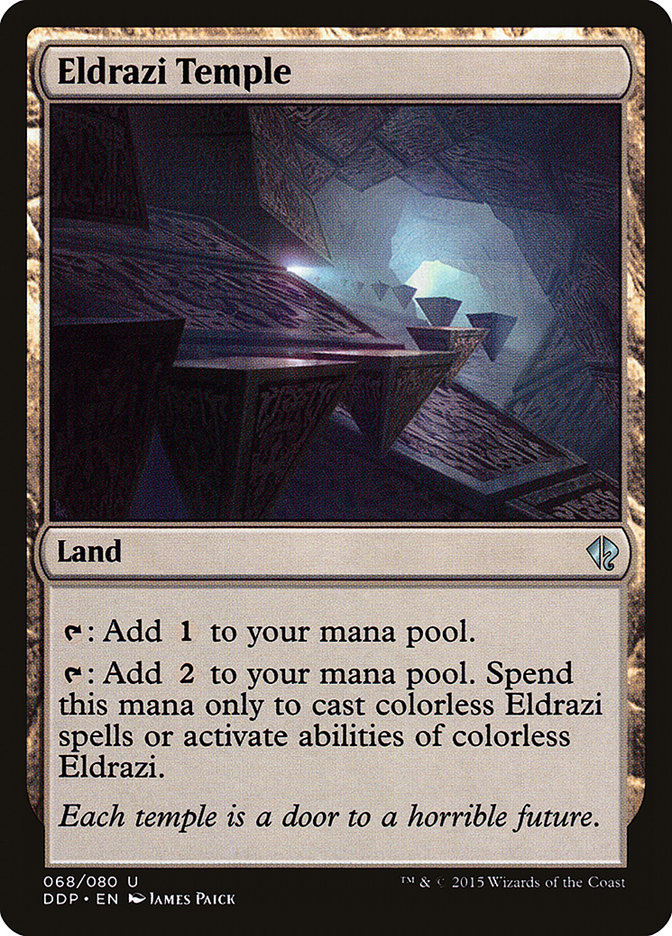By all accounts, this was not a great year for me and Magic. On the other hand, there were parts of this year that were simply incredible. As just one example, as I write this, it is the year anniversary for me having first met my significant other Andrea, which is a pretty damned great thing.
But, of course, I’m guessing you’re more interested in thinking about Magic than about my personal life, so I won’t go into the grand journey of this year’s romance. Instead, I’m going to share with you an overview of my Magic year, with an eye for looking forward to another year of Magic in 2017.
Let’s get cracking!
January
In many ways, I think the beginning of the year was really a time of recovery and reflection. The upcoming Pro Tour was in a huge and difficult format, Modern.
The Eldrazi were not yet out in force, but as spoilers came in, it was becoming clear that there were going to be real changes on the horizon. There were a lot of options for what I could play in the format, and I was still trying to go through them all. I hadn’t yet figured it out, but I was still in the position where I had over half a dozen decks in my docket. Here’s what I wrote to my team early that month:
What are your (very) preliminary deck preferences? I, like Zvi, feel like this is a format that better suits practice with your deck.
As of today, my preferences are:
1st – Lantern Control
2nd – Burn
3rd – Grixis Control
4th – G/B Decks
5th – U/R Delver
6th – Random creature-based linear decks
7th – G/W Hate Bears
I know that is a lot of stuff. I strongly recommend, if you’re like me and have a huge list of decks you’re considering, narrowing that list down as quickly as possible, and getting in maximum practice.
About all I had figured out was my travel plans. I had decided to drive.
Over the last couple of years, driving has become one of my favorite ways to get to a Magic event within a certain radius.
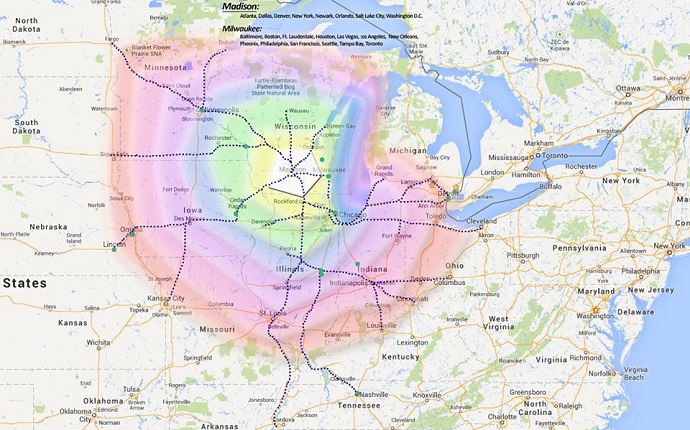
Hell, I don’t mind going further than this; as you’ll see, I’ll drive even further than this if the conditions are right.
Practice, practice, practice. Modern is a big animal, and the whole set wasn’t even fully available until the middle of the month, but I knew I could at least get some general outlines in, even without the new set. A banning announcement would soon be coming, and while we could guess what might be coming, we didn’t know.
Since I was driving, I reached out to Jeff Hoogland to make a playtesting plan. He’s such a grinder on Modern, I figured it wouldn’t hurt to sit down in person with someone who would have a wildly different perspective than me.
As the month closed, I ground out a ton of drafts in Madison, and felt like I had a really great handle on Oath of the Gatewatch Limited. I’d limited my deck choices down to five large groups of decks, and while I was still apprehensive about the coming event, I felt like I’d done a ton of work.
What I’d do differently: I think I kept my options too open. This was probably because of the uncertainty created by a potential banning, but here, I believe I could still have narrowed my focus down to at least half of what I had looked at, and still allowed myself the room to change paths if need be. In trying to be open to everything, I didn’t go deeply on anything.
February
I only had the one big event in February: Pro Tour Oath of the Gatewatch in Atlanta.
After countless playtest sessions, my top contenders were Lantern and, shockingly to many, Soul Sisters.
Here is the list I played:
Creatures (31)
- 4 Soul Warden
- 3 Auriok Champion
- 4 Sky Hussar
- 4 Norin the Wary
- 2 Ranger of Eos
- 3 Soul's Attendant
- 4 Ajani's Pridemate
- 4 Champion of the Parish
- 1 Legion Loyalist
- 2 Purphoros, God of the Forge
Planeswalkers (1)
Lands (20)
Spells (8)
Sideboard

I loved how the deck played against (nearly) every deck that attacked. I expected Burn to be popular, and I’d been seeing an uptick on Death’s Shadow decks online. I liked the deck against the two Eldrazi decks we had found. After my playtest session with Hoogland, I even liked the deck against Jund and Grixis, two matchups that had felt more difficult in the past.
I did not like the deck against Infect at all; it was a horrible matchup, though a matchup that could be won with a bit of luck. There were a few other matchups that were more difficult, but still quite close, like Valakut and Tron.
I went 3-2 with the deck, losing to Infect and Scapeshift, while resoundingly crushing my other opponents, Burn, Death’s Shadow, and Jeskai Control. This might have been serviceable had it not been for the 0-3 record in the draft. Reflecting on it later, I found myself thinking that, perhaps despite all of the drafting I did, I was so focused on trying to solve Modern, I did fewer drafts than I should have by a good margin.
What I’d do differently: Most of the thrust of this goes back to January. I had worked hard to try to solve a format that isn’t currently solvable. The time I spent in January stretched into the time I’d spent in February. I should have focused on a deck, honed the hell out of it, and gotten to know it so deeply inside and out that it was second nature to play, and used that extra time to do more drafts. It’s simple in retrospect, but at the time, I think I got lost in my love to solve a puzzle.
March
In March, I hit two Grand Prix on a single trip, driving first to Detroit and then to D.C. on an epic eleven day trip.
Detroit was a somewhat awesome trip. I got to visit a lot of old friends, including my friend Jen and a college friend, Carly.
The deck I built was somewhat wild. It was essentially designed to target two disparate decks: Eldrazi and Chord of Calling decks. It was quite successful at this job, despite being a pretty wild-looking deck. Here is my Mardu Planeswalkers deck whose pet name was “The Hellfire Club”:
Planeswalkers (10)
- 2 Gideon Jura
- 2 Karn Liberated
- 1 Sorin, Lord of Innistrad
- 2 Elspeth, Sun's Champion
- 3 Chandra, Flamecaller
Lands (25)
Spells (25)

I crushed a lot of Eldrazi over the weekend, though I was wildly soft to Burn decks. I did manage to beat one Burn deck, but it felt a little lucky, if I’m going to be honest.
Looking at this deck now, I still find myself thinking, “Wow, this deck is great, but what if I’d just played Lantern!?” And I also find myself champing at the bit to remake this cool deck with a new tool:
A 10-5 record isn’t great, and I can still see a few moments where things could have gone differently. I got very unlucky to lose to two of my opponents, and while I am fully aware that luck swings every which way, it still hurts when it swings the wrong way for you.
Moving onward, I drove on towards Washington, D.C., ready to battle with two friends I had teamed with on Team UltraPro, GP Top 8 Veterans Brian Kowal and David Heinemann. I respect both guys a lot, but they’re also super-great friends, so I was excited for the event.
The day started poorly, with a draw against our Round 1 opponent. It ended poorly as well, with a loss on our win-and-in for Day 2. Ultimately, though, I think we probably didn’t deserve a top finish: we definitely misbuilt our decks, and when every one of your three decks is misbuilt, the lost value adds up. On a positive note, our friend Matt Severa won the GP with his teammate and our fellow Madisonians Sam Black and Justin Cohen.
What I’d do differently: I absolutely loved the Modern deck I’d played, but I think I should have just played Lantern. Modern rewards specialization, and it was the deck I knew best. In terms of the Team Limited GP, while I love both Brian and David, I think both guys were largely on their way out of the game, and I knew it. I should have set up a team well before the Grand Prix with two folks who were as dedicated to Magic as I would have liked. While I loved playing with them, I care enough about winning, it would have probably been better if I’d been working with people with a similar Magic drive.
April
April was basically my month of Spain.
Outside of the tournaments, one of the things I was most excited about was the chance to see my old Magic friend Ellen Koberer, whom I probably hadn’t seen since the turn of the century. She is one of the unsung heroes of deckbuilding, having built the coolest Yawgmoth’s Will deck at the Tolarian Academy-dominated PT Rome and many other decks besides.
Heading out to Spain marked the first collaboration between Team Mad Apple – the Madison/NYC-based team I was a part of – and Team Hot Sauce, the PT team captained by Adam Jansen. Our first house together, we gathered a gaggle of us in Barcelona to practice: me, Jansen, Greg Orange, and Ray Perez, Jr., with more of us to gather together in a huge house in Madrid.
The GP went fairly well, though not incredibly so. I had an utterly terrible deck in the Sealed, but it at least had a little bit of play. I felt supremely confidant in the draft, and I finished at 11-4 in the event, less well than I’d hope at the beginning of the weekend, but better than I’d expected after opening my Sealed pool.
For the Pro Tour, I had a powerful Mardu Control deck that I loved a great deal. I also had a very strong B/G Control deck that basically looked like a pre-Emrakul B/G Delirium deck. I didn’t have the details worked out to my satisfaction, but it was still there on my radar. Interestingly, all of the components for a blue Eldrazi deck were available, but I hadn’t (yet) gotten onboard with that.
I’m not sure it would have mattered. Nahiri, the Harbinger was a huge force in my testing. It would have become hard to find another deck, given how much she kept impressing me. The B/G deck was powerful but not ready, and the other decks on the radar, U/R Turbo Sphinx’s Tutelage, R/G Ramp, G/W/u Cryptolith Rite, W/U Ojutai Midrange (“OJ is Watching”), and Four-Color Company weren’t inspiring me the way the Mardu deck was. Most of the two teams either played it or a two-color B/R variant of the deck.
Unfortunately for me, in two aggressive matchups, I had some wretched mulligans that amounted to the same results: barely losing. In one case, versus White Humans, I got knocked to exactly zero, with only an untap phase between me and completely stabilizing. I didn’t make Day 2. Most of the other players of the deck did very well, though Gaudenis Vidugiris joined me in obscurity for the event.
What I’d do differently: Throughout my testing, I loved Ulamog, the Ceaseless Hunger, but I didn’t really develop anything with the card other than finding it a horrifying card to face in R/G Ramp. What I did have, though, was a B/G deck that, after sideboarding, was a midrange powerhouse. If I could have focused on finding an Ulamog deck, tuning the B/G deck, and finding my favorite Nahiri deck, I think my outcomes would have been much better.
May
By this point, I’d had enough of the format that I’d found a version of Mono-Blue Eldrazi that I liked for Standard:
Creatures (7)
Planeswalkers (2)
Lands (28)
Spells (23)

It wasn’t fully honed, but I loved it overall. There were some mistakes in the deck that I figured out as the event was underway. One of the biggest was Harbinger of the Tides, a card I’d conceived of as a help against White Humans but also liked against Gideon, Ally of Zendikar, more generally.
I should have been playing Warping Wail, but I hadn’t given the card any credence because it didn’t seem “good enough,” even though it definitely, in the end, was. Later yet, I would figure out some other things that should have been different about the deck, but this was still very early in the archetype.
Later, I hit up North Carolina on an epic road trip with Andrea, and after visiting her friends and family, hit Charlotte with only a single Modern deck at the ready: Lantern. While I won some and lost some, it felt like a great choice. I knew the deck intimately, I knew how to play against the format with it, and it served me well. I only finished 9-6, but these matches all felt like they were in play and could easily have gone the other way.
What I’d do differently: Charlotte, despite a mediocre finish, showed me the value of really knowing your deck choice. Conversely, in Standard in NYC, I was quite new to the Eldrazi deck, and the people who had had some success with the mono-blue versions of the deck were all running Warping Wail. Despite not have much experience with the deck, I assumed that the Wails were “an obvious mistake,” but hadn’t bothered to really sit down and test them. If I had, I would have known better, and at the very least had three mostly-dead cards out of my deck. Given my lack of experience, I should have been more respectful of other peoples’ successes.
June
In June, I hit GP Columbus, Death and Taxes fully in tow. My build was slightly different.
Creatures (25)
- 4 Mother of Runes
- 2 Mangara of Corondor
- 1 Aven Mindcensor
- 3 Flickerwisp
- 4 Stoneforge Mystic
- 4 Phyrexian Revoker
- 4 Thalia, Guardian of Thraben
- 3 Eldrazi Displacer
Lands (24)
Spells (11)

43rd place is good, though not tip-top. What felt really good about this list, though, was how well it could fight any old opponent. The potential exception was the current top deck in the format.
Creatures (8)
Planeswalkers (2)
Lands (22)
Spells (28)

I can make a Death and Taxes deck that will beat this deck handily. The big problem, however, is can it beat other builds of Miracles.
Creatures (6)
Planeswalkers (2)
Lands (21)
Spells (31)

Creatures (4)
Planeswalkers (3)
Lands (22)
Spells (31)
- 4 Sensei's Divining Top
- 4 Brainstorm
- 3 Counterspell
- 3 Force of Will
- 4 Swords to Plowshares
- 1 Stifle
- 1 Misdirection
- 2 Back to Basics
- 3 Counterbalance
- 1 Spell Pierce
- 1 Entreat the Angels
- 2 Terminus
- 1 Supreme Verdict
- 1 Council's Judgment
Sideboard

All of these decks are only slightly different in their execution, but the details matter a lot. Monastery Mentor doesn’t forgive you for letting it go unchecked for a few turns. However, what are the cards that you can use against it that are generally good against the rest of the deck? Importantly, many builds of this deck don’t even use the card. I played against Miracles twice and split the difference against it, going 1-1.
My other losses at the event were to ANT and Grixis Delver. I also got a draw in the mirror. Of the four non-wins I had, I definitely feel like play mistakes took the cake, turning a win into a draw and putting another match from “maybe win” to “definitely lose.” Even just changing up that draw would put me into the Top 32 or Top 16 depending on breakers. In both cases, rushing on plays was the culprit.
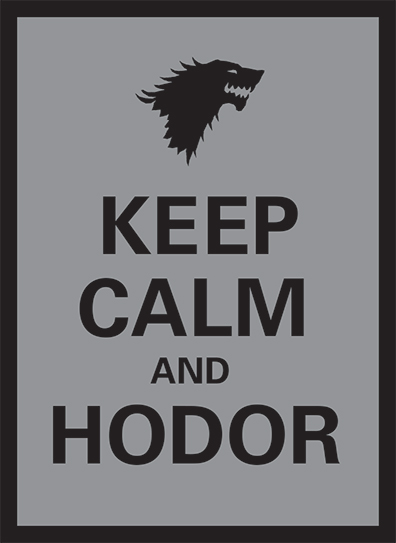
Later that month, I hit GP Pittsburgh, rocking Mono-Blue Eldrazi, and I basically got crushed. The best Humans decks were simply too fast for it, and I made a decision to ignore them and hope to dodge them. Losing sent me down to the Humans bracket, and it was a quick “Humans, lose, Humans, lose, Humans, lose” day for me.
What I’d do differently: Breathe. Keep calm. Don’t rush the play. I’m very good at paying attention to time on the clock, so just taking those moments to breathe are important, lest you let the win slip out of your fingertips. Honestly, this is probably my lifelong biggest problem in Magic: just making a play too quickly, and not winning when I should have. I don’t regret my deck selection in either event: I was sticking to the decks I knew, and that’s good.
July
Of course, I didn’t keep it up. The only event I had in July was a WMCQ, and after tossing about, I went with Grixis, largely out of fear of playing Lantern against Jund.
Steve Rubin and I shared a room in Lincoln, and had a great time out with friends like Corey Burkhart. Sadly, none of us won it, but my choice to go Grixis didn’t pan out. Really, having the fear of any deck shouldn’t knock you out of your deck of choice unless that deck is the wildly most popular. Jund wasn’t. I should have Lanterned.
What I’d do differently: Stay the course. Modern is too big a format to be scared of a deck in the metagame. Just play the deck you know unless something is insanely good or the deck you fear is the most popular deck.
August
Sydney. Eldritch Moon.
This was going to be a big deal. It was the end of the season and I needed a good finish if I was going to re-up on Gold.
I selected a great deck, B/G Delirium, and again, I knew the format really well.
My draft deck was incredible. And, of course, I started with a play mistake in Round 1 to lose the match, and then a play mistake in the second match, also to lose. My second draft deck was also incredible, and I lost an epic match versus Martin Muller that involved him getting a turn 6 kill with a double-striking Stensia Innkeeper that jumped into the sky and was pumped to take me exactly to dead while he faced lethal in the form of The Gitrog Monster and two other mythic rares.
After a few more losses, the dream for the year was dead.
There was a feeling of despair after that last important loss, as I realized I had not made my goal of Gold for the year. I replayed all of the moments as they had gone wrong. Mostly it involved mistakes. They were either in-game mistakes, or mistakes of judgment. If I looked at it, the year was full of them.
So, I went on to Portland to start the new season, and of course started with a mistake of judgment.
I was catching up with my old friend Joel Priest (of Snuff-O’Derm fame), and I managed to talk both him and our friend Richie Frangiosa into playing their first GP in almost ten years. I was so excited about getting him to play that I let him play the U/R Fevered Visions deck that I’d been considering playing, despite the fact that I thought it was likely the best deck. Midway into the day, I was dead for Day 2, and he dropped at 6-1 because he had some fun non-Magic event in town he wanted to go to.
What I’d do differently: If you’re going to have goals, you should focus on attaining them. This meant that, despite me wanting Joel to play in the event, I should have selected the deck that I thought was best for the event rather than let him pick it. This meant that if I was going to select re-attaining Gold as my goal for the season, I needed to focus on each match like it mattered, because they basically all do. Getting lazy or sentimental doesn’t help any of that.
September
It was late in September that the new set, Kaladesh, came out, and I hopped into preparation. Draft, draft, draft.
Before that, though, was largely a time of recuperation. I kept up on my game by playing online as much as possible, just trying to keep a good balance by the time Kaladesh was underway.
The respite from events felt good.
What I’d do differently: Not much. Keeping a balance in life is important. After the failure of the season, I needed a breather to recuperate, and this helped.
October
I finished PT Kaladesh with an 8-8 record, wildly disappointing after a 5-0 beginning in Constructed with the awesome-feeling Tamiyo, Field Researcher deck I’d brewed.
Creatures (20)
- 3 Woodland Wanderer
- 4 Sylvan Advocate
- 4 Archangel Avacyn
- 2 Tireless Tracker
- 4 Spell Queller
- 3 Servant of the Conduit
Planeswalkers (4)
Lands (26)
Spells (10)

The other decks I felt good about for the event were Mardu Vehicles and a Jeskai Control deck. I was working with a large handful of PT rookies who were qualified out of Madison, and when I hit the testing house in Honolulu with a Jeskai Control deck that I felt good about, I basically got crushed in matchups that had felt good when testing with the rookies.
It made me spin a bit, ultimately, just days before the event. I was flailing trying to find a deck I felt good about. None of the rest of the members of the Mad Apple/Hot Sauce conglomerate were fully convincing about any other deck that we might play, and I was now having to backtrack into the decks I’d given up on.
Tamiyo lured me back, in large part because she was so good against Aetherworks Marvel decks and the various R/W(/x) Vehicles decks we expected. The mana wasn’t perfect, and there were other problems with the deck, but it was better than all of the other things I had on my docket.
After the Pro Tour, I was back to a place I hadn’t been in a while: no longer qualified and needing to fight to get back on. My first attempt was the GP in Providence, where I went back to an updated version of the Jeskai Control deck that I’d abandoned for the PT.
I lost my first round playing the deck in Round 3 because my opponent drew all of his Scrapheap Scroungers in Games 2 and 3, and I couldn’t overcome them. I drew another round in a match I could have won if I’d managed my clock better in a game I was losing. My other losses didn’t really feel like mistakes in play, but they certainly felt like mistakes in construction.
Not an auspicious start.
What I’d do differently: I did as much playtesting as I could for these events, but basically, I didn’t take into account how much more effort I’d need to put into playtesting if I was going to work with less experienced players. I put in weeks of work, but ultimately, I should have spent more time with more experienced players, if only online, to make sure I wasn’t skewing my results. By the time I’d gotten to the Grand Prix, I was still behind the curve of where I’d wanted to be because of that lost time with a reality check on the format.
November
With the Thanksgiving holiday, and the crushing defeat of Honolulu, I did what I did in September: I recovered. Travel takes its toll and I needed to reflect on what the plan was going to be going forward.
What I’d do differently: Not a thing. This was a good month. Reflection is important if you recognize you need to change.
December
The gaming calendar ended for me in Milwaukee with a Limited GP. I was excited for the event and prepared as much as I could. The month began with an RPTQ in Modern, where I’d dedicated myself to Lantern.
Neither event was particularly noteworthy. I finished ninth at the RPTQ, and in Milwaukee, I had a Sealed Deck that was awarded a consensus review of “Wow, this is a horrible pool” from the Madison crew.
The failure to requalify at the RPTQ was a hard blow, as it meant I wouldn’t be qualified for the Pro Tour for the first time since Pro Tour Fate Reforged. The GP was disappointing, if only because I worked my pool so hard to try to get anything of worth out of it, but I just didn’t have the goods to get it done.
I don’t know if I could have changed either result. My losses at the RPTQ were incredibly close, and both basically good games. There’s not much you can do with a horrible pool other than do your best on the build, and the consensus was that I was only one spell off in my build.
Sometimes you can be ready, and it just doesn’t go your way.
What I’d do differently: Losses, especially important ones, can be emotionally crushing. But they will inevitably happen. While I don’t want to ever plan on losing, as I think that frame of mind can keep one from winning, I think keeping in mind what the consequences of losing fully meant for my Magic calendar would have helped focus me in a positive way that could help inspire wins rather than losses. When you’re hungry for a win for the sake of a goal, you can find paths in games that might cause a win where otherwise you might not have.
2017
And so we get to the upcoming year.
I may not be qualified for PT Aether Revolt in Dublin, but I’ve built my Magic calendar and am looking at all of the events I’m planning on attending. The next one is just around the corner, GP Louisville and Legacy.
Last year, my goal was to maintain Gold. This year, my goal is to requalify for the Pro Tour.
I know the things that are going to help me do that are things anyone can do. Practice. Take care in choosing a deck. Learn the ins and outs of that deck.
One thing I’m very hopeful for, though, moving forward, is the change that is happening structurally to tournament Magic that I think will be very good for me.
You probably know that Standard is going to be returning to a once-yearly rotation from a twice-yearly rotation.
This is great for me.
I tend to be at my best when I’ve had sufficient time to revise and hone an idea. The U/W Control deck that I used to qualify for the Pro Tour at GP Chicago was the result of months and months of honing. Prior to that, when Matt Sperling was hunting for a deck for PT Magic 2015, I gave him full 75 card lists of honed versions of many archetypes (my top picks: U/W Control, Burn, and Stompy) because I’d explored the format so intensely.
At PT Dragons of Tarkir, I’d literally been playing a version of the deck I Top 8ed with for months.
With the shift to the faster rotation, I’ve felt completely out of sort in Standard for the entirety of the time it’s been on a twice-yearly rotation. Just as I’m getting to really like a deck because I understand what it is I want to accomplish, the world utterly changes and the deck goes away.
The next set after Aether Revolt is Amonkhet and it will be followed by Hour of Devastation. We won’t see a rotation until after that.
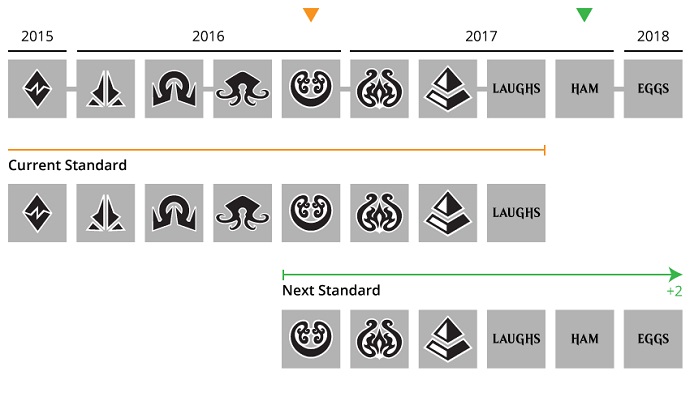
Image from Wizards of the Coast.
I must say, that is music to my ears, and I think it will be a huge help for my goals in 2017, at least as it relates to Standard.
What are your goals for 2017? How do you hope to achieve them? Having answers to those two questions is the first step you should take if you hope to improve and succeed.
I’m on my quest. Wish me luck. I wish you luck on yours.
See you next year!



